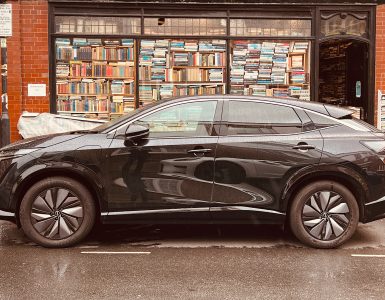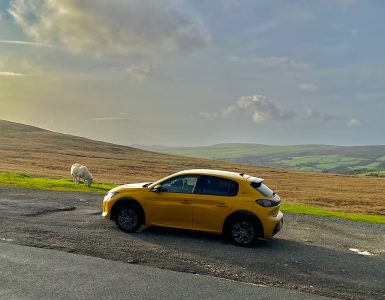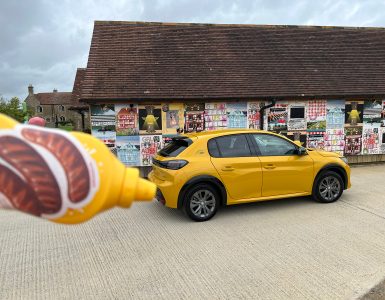The Tesla Model 3 is one of the most advanced cars in the world, a car that is coaxing buyers away from combustion powered German premium rivals. So what is like making the switch… what is good and what is bad.

2nd Report – First 3 weeks with a Model 3
From the moment the Model 3s silently eases out of the delivery area near Heathrow (or tries to..they have a squeaky floor), you know this car is different, certainly from the petrol Mini, diesel BMW 330D & Range Rover Evoque and most recently Petrol Skoda Karoq that have been my wheels since 2003.
The first thing that strikes you is how silent the Model 3 is especially at low speeds along with how uncluttered and minimalist the interior is. Operating everything via the ipad style screen & a few stalks & buttons on the steering wheel takes a little getting used to but is mostly intuitive. In the end though the key feeling you get is.. this is simply a more advanced and better technology than any diesel or petrol powered car.
Having covered 800 miles since that first day the key takeouts are.. that same feeling, the car demonstrates how EVs change the rules and are simply better than the petrol & diesel models they will replace. The Model 3 is quieter and smoother than a German premium saloon at lower speeds, has simply astonishing acceleration that leaves a BMW M3 and even a Mercedes AMG GT R performance for dust and yet costs less than a Ford Fiesta to charge and to service. The handling, ride and grip are impressive, while the low centre of gravity keeps the car flat in corners and seems, so far, to have prevented any signs of car sickness on windy roads for my sometimes susceptible family! So far everyone is stepping out of the car feeling fresher than in our previous cars. Occasional charge stops after every 4 hours or so of driving help this too!
Range
Electric vehicle technology at the moment rewards the most efficient design. Cars like the Model 3, Kia E-Niro and Hyundai Kona are all in the almost magical sweet-spot of great performance and long real world range. The VW Id 3 should be as well.
By contrast some heavy less aerodynamic and less efficient EVs, like the Audi e-tron, Mercedes EQC, Tesla Model X and Jaguar iPace are great cars, but end up struggling to achieve a real world range much over 220 miles even though their batteries are much bigger (and heavier) than the 74kWh on this Model 3. This in turn means more stops on long journeys and, if they don’t have charging speeds well over 100kW, quite lengthy charging times.
The Model 3 performance with aero wheels is easily able to achieve a real world range of 280 to 310 miles. Expect up to 10% less range on bigger alloys.
This Tesla gives you your current range based on standard power consumption of 250kW per mile or 4 miles per kWh.
The energy graph function below shows you a this as a solid line and compares it to your own energy use over the last 5, 15 or 30 miles which is shown as a dotted line. If your dotted line is above the solid line you’re using more energy than 250w per mile and you’ll get shorter range than the 4 miles per kW expected, if it’s below you’ll go further.

In English daytime traffic where even motorway speed speeds are often between 40 and 75 mph, driving efficiently is not a challenge as long as you leave regenerative braking in standard mode. If you ever found a UK motorway where traffic was so light you could choose to travel at 80 to 90mph for most of a journey then range would suffer, although less than on some other EVs.

In our first report we covered the delivery experience
Report 1 – The UK pre-delivery experience
Frustrating! Tesla UK is having to scale up to around 10x the deliveries they had before June 2019 but even taking that into account as at August 2019 the delivery experience is poor especially the communication – you will need to be patient & assume no delivery window you are told about is definite until a very short time before actual delivery. The difficulty getting through by phone would be less frustrating if either the app, the web portal, the texts you receive or the systems Tesla staff used were able to provide even a vague idea of delivery times.
Having ordered a long range dual motor in May but with no indication of delivery week or month I was fortunate – when I told a very helpful Tesla employee that I was prepared to be flexible on spec & colour, he came back quickly with an unmatched Performance Model available for immediate delivery. Three working days later I was collecting the car in time for the September 2019 number plate change. If I hadn’t had the conversation I did and stuck to my original order the delivery might have taken a month or 2 longer.
The spec of this car is a little unusual as the Performance Model normally includes a “performance pack” that provides:
- Lowered suspension
- 20″ Alloy wheels
- Enhanced red brakes
- a spoiler
- a top speed increase from around 145 to 162mph
- track mode
The Model 3 Performance without performance pack was slightly cheaper and does not include any of these enhancements and uses 18″ aero wheels. So was this temporarily available version a poor spec model? Not really. The unique selling point about the performance is that it accelerates from 0-60 mph in around 3.3 seconds. This version of the Model 3, known by some US owners as the “stealth performance” might not feel quite a sporty in its handling but it will ride more smoothly and a lot further on its 18 inch aero wheels. The range it will achieve should be better than a normal performance but less than a dual motor long range on standard aero wheels. As a day to day car it might prove ideal.
Report 1 – Delivery experience
Once delivery is confirmed things run much better with regular phone and email contact.

One thing worth knowing – Tesla ask for payment by bank transfer. They will Confirm receipt if you want to send a small test payment of say £10 to ensure you really are sending your funds to the right account. I would recommend you always do this with any large transaction. It’s also worth being aware that many banks limit how much money you can send in a day and will not reset your maximum transfer limit over a weekend or a public holiday. So do allow enough time to send the full amount due or you won’t be able to collect your car on the day arranged!
The handover is a fun experience with other excited owners also picking up their cars. There is an opportunity to familiarise yourself with the car and ask any questions.






